An Integrated Automatic Writing Evaluation and SVVR Approach to Improve Students’ EFL Writing Performance
Abstract
:1. Introduction
2. Literature Review
2.1. AWE for EFL Writing
2.2. SVVR-Supported EFL Writing
3. Integrated AWE and SVVR Approach for EFL Writing
3.1. Concrete Experience
3.2. Reflective Observation
3.3. Abstract Conceptualization
3.4. Evaluation and Reflection
4. Method
4.1. Participants
4.2. Experiment Procedure
4.3. Measuring Instruments
4.3.1. Rubric of English Writing Performance
4.3.2. Learning Motivation
4.3.3. Writing Self-Efficacy
4.3.4. English Writing Anxiety
4.3.5. Sense of Presence Questionnaire
4.3.6. Interview Outline and Coding Scheme
- (1)
- What do you believe you have benefited from learning English writing using this method the most? Which aspect did you learn the most about? Give us a specific illustration, please.
- (2)
- How is this method for learning EFL writing different from EFL writing classes you have previously taken (or expected)? Do you think it’s effective? Why? Do you agree with the way it is used? How does it help you?
- (3)
- What are the advantages of this learning approach in general?
- (4)
- What aspects of the learning process (such as the functionality or interface design) could be improved? Please give us an example.
- (5)
- Would you like to have the opportunity to learn to use this method again in the future? Which courses might it be applied to? Why do you believe these courses are appropriate for this strategy?
- (6)
- Would you recommend other students to use this learning approach? Why, in your opinion, do they need to learn in this manner? Or would they prefer to learn this way?
- (7)
- Would you advise other educators to adopt this teaching strategy? Why do you think they need to use this teaching strategy? Or would they be open to adopting this in-structional strategy?
5. Results
5.1. Analysis of Learning Outcomes
5.2. Analysis of Learning Motivation
5.3. Analysis of Writing Self-Efficacy
5.4. Analysis of English Writing Anxiety
5.5. Analysis of Sense of Presence
5.6. Interview Results
6. Conclusions
7. Discussion
Author Contributions
Funding
Institutional Review Board Statement
Informed Consent Statement
Data Availability Statement
Conflicts of Interest
References
- Wang, S.; Xu, H. Design of an Intelligent Support System for English Writing Based on Rule Matching and Probability Statistics. Int. J. Emerg. Technol. Learn. 2018, 13, 157–169. [Google Scholar] [CrossRef]
- Lv, X. A study on the application of automatic scoring and feedback system in college English writing. Int. J. Emerg. Technol. Learn. 2018, 13, 188–196. [Google Scholar] [CrossRef]
- Hwang, W.Y.; Chen, H.S.; Shadiev, R.; Huang, R.Y.M.; Chen, C.Y. Improving English as a foreign language writing in elementary schools using mobile devices in familiar situational contexts. Comput. Assist. Lang. Learn. 2014, 27, 359–378. [Google Scholar] [CrossRef]
- Carless, D. Feedback loops and the longer-term: Towards feedback spirals. Assess. Eval. High. Educ. 2019, 44, 705–714. [Google Scholar] [CrossRef]
- Liu, C.; Hou, J.; Tu, Y.F.; Wang, Y.; Hwang, G.J. Incorporating a reflective thinking promoting mechanism into artificial intelligence-supported English writing environments. Interact. Learn. Environ. 2021, 1–19. [Google Scholar] [CrossRef]
- Barrot, J.S. Using automated written corrective feedback in the writing classrooms: Effects on L2 writing accuracy. Comput. Assist. Lang. Learn. 2021, 1–24. [Google Scholar] [CrossRef]
- Link, S.; Mehrzad, M.; Rahimi, M. Impact of automated writing evaluation on teacher feedback, student revision, and writing improvement. Comput. Assist. Lang. Learn. 2022, 35, 605–634. [Google Scholar] [CrossRef]
- Wang, Y.J.; Shang, H.F.; Briody, P. Exploring the impact of using automated writing evaluation in English as a foreign language university students’ writing. Comput. Assist. Lang. Learn. 2013, 26, 234–257. [Google Scholar] [CrossRef]
- Dikli, S.; Bleyle, S. Automated essay scoring feedback for second language writers: How does it compare to instructor feedback? Assess. Writ. 2014, 22, 1–17. [Google Scholar] [CrossRef]
- Stevenson, M.; Phakiti, A. The effects of computer-generated feedback on the quality of writing. Assess. Writ. 2014, 19, 51–65. [Google Scholar] [CrossRef]
- Waer, H. The effect of integrating automated writing evaluation on EFL writing apprehension and grammatical knowledge. Innov. Lang. Learn. Teach. 2021, 13, 5842. [Google Scholar] [CrossRef]
- Palermo, C.; Thomson, M.M. Teacher implementation of self-regulated strategy development with an automated writing evaluation system: Effects on the argumentative writing performance of middle school students. Contemp. Educ. Psychol. 2018, 54, 255–270. [Google Scholar] [CrossRef]
- Wilson, J.; Czik, A. Automated essay evaluation software in English Language Arts classrooms: Effects on teacher feedback, student motivation, and writing quality. Comput. Educ. 2016, 100, 94–109. [Google Scholar] [CrossRef]
- Chen, Y.T.; Li, M.; Huang, C.Q.; Han, Z.M.; Hwang, G.J.; Yang, G. Promoting deep writing with immersive technologies: An SVVR-supported Chinese composition writing approach for primary schools. Br. J. Educ. Technol. 2022. [Google Scholar] [CrossRef]
- Huang, H.L.; Hwang, G.J.; Chang, C.Y. Learning to be a writer: A spherical video-based virtual reality approach to supporting descriptive article writing in high school Chinese courses. Br. J. Educ. Technol. 2020, 51, 1386–1405. [Google Scholar] [CrossRef]
- Chien, S.Y.; Hwang, G.J. A question, observation, and organisation-based SVVR approach to enhancing students’ presentation performance, classroom engagement, and technology acceptance in a cultural course. Br. J. Educ. Technol. 2022, 53, 229–247. [Google Scholar] [CrossRef]
- Hosseini, M.; Swaminathan, V. Adaptive 360 VR video streaming: Divide and conquer. In Proceedings of the 2016 International Symposium on Multimedia (ISM), San Jose, CA, USA, 11–13 December 2016; pp. 107–110. [Google Scholar] [CrossRef]
- Walshe, N.; Driver, P. Developing reflective trainee teacher practice with 360-degree video. Teach. Teach. Educ. 2019, 78, 97–105. [Google Scholar] [CrossRef]
- Chien, S.Y.; Hwang, G.J.; Jong, M.S.Y. Effects of peer assessment within the context of spherical video-based virtual reality on EFL students’ English-Speaking performance and learning perceptions. Comput. Educ. 2020, 146, 103751. [Google Scholar] [CrossRef]
- Wang, Z.; Guo, Y.; Wang, Y.; Tu, Y.F.; Liu, C. Technological Solutions for Sustainable Development: Effects of a Visual Prompt Scaffolding-Based Virtual Reality Approach on EFL Learners’ Reading Comprehension, Learning Attitude, Motivation, and Anxiety. Sustainability 2021, 13, 13977. [Google Scholar] [CrossRef]
- Lin, H.C.; Hwang, G.J.; Hsu, Y.D. Effects of ASQ-based flipped learning on nurse practitioner learners’ nursing skills, learning achievement and learning perceptions. Comput. Educ. 2019, 139, 207–221. [Google Scholar] [CrossRef]
- Kolb, D.A. Experiential Learning: Experience as the Source of Learning and Development; FT Press: Upper Saddle River, NJ, USA, 2014. [Google Scholar]
- Jiang, L.; Yu, S. Appropriating automated feedback in L2 writing: Experiences of Chinese EFL student writers. Comput. Assist. Lang. Learn. 2022, 35, 1329–1353. [Google Scholar] [CrossRef]
- Li, J.; Link, S.; Hegelheimer, V. Rethinking the role of automated writing evaluation (AWE) feedback in ESL writing instruction. J. Second. Lang. Writ. 2015, 37, 8–25. [Google Scholar] [CrossRef]
- Ranalli, J.; Link, S.; Chukharev-Hudilainen, E. Automated writing evaluation for formative assessment of second language writing: Investigating the accuracy and usefulness of feedback as part of argument-based validation. Educ. Psychol. 2019, 27, 1178–1191. [Google Scholar] [CrossRef]
- Wilson, J.; Ahrendt, C.; Fudge, E.A.; Raiche, A.; Beard, G.; MacArthur, C. Elementary teachers’ perceptions of automated feedback and automated scoring: Transforming the teaching and learning of writing using automated writing evaluation. Comput. Educ. 2021, 168, 104208. [Google Scholar] [CrossRef]
- Wilson, J.; Roscoe, R.D. Automated writing evaluation and feedback: Multiple metrics of efficacy. J. Educ. Comput. Res. 2020, 58, 87–125. [Google Scholar] [CrossRef]
- Liu, Q.; Brown, D. Methodological synthesis of research on the effectiveness of corrective feedback in L2 writing. J. Second. Lang. Writ. 2015, 30, 66–81. [Google Scholar] [CrossRef]
- Wilson, J.; Huang, Y.; Palermo, C.; Beard, G.; MacArthur, C.A. Automated feedback and automated scoring in the elementary grades: Usage, attitudes, and associations with writing outcomes in a districtwide implementation of MI Write. Int. J. Artif. Intell. Educ. 2021, 31, 234–276. [Google Scholar] [CrossRef]
- Ranalli, J. Automated written corrective feedback: How well can students make use of it? Comput. Assist. Lang. Learn. 2018, 31, 653–674. [Google Scholar] [CrossRef]
- Guo, Q.; Feng, R.; Hua, Y. How effectively can EFL students use automat-ed written corrective feedback (AWCF) in research writing? Comput. Assist. Lang. Learn. 2021, 1–20. [Google Scholar] [CrossRef]
- Fu, Q.K.; Zou, D.; Xie, H.; Cheng, G. A review of AWE feedback: Types, learning outcomes, and implications. Comput. Assist. Lang. Learn. 2022, 1–43. [Google Scholar] [CrossRef]
- Lee, I. Teachers’ frequently asked questions about focused written corrective feedback. TESOL J. 2019, 10, e00427. [Google Scholar] [CrossRef]
- Gunn, T.; Jones, L.; Bridge, P.; Rowntree, P.; Nissen, L. The use of virtual reality simulation to improve technical skill in the undergraduate medical imaging student. Interact. Learn. Environ. 2018, 26, 613–620. [Google Scholar] [CrossRef]
- Wu, W.L.; Hsu, Y.; Yang, Q.F.; Chen, J.J.; Jong, M.S.Y. Effects of the self-regulated strategy within the context of spherical video-based virtual reality on students’ learning performances in an art history class. Interact. Learn. Environ. 2021, 1–24. [Google Scholar] [CrossRef]
- Passig, D.; Tzuriel, D.; Eshel-Kedmi, G. Improving children’s cognitive modifiability by dynamic assessment in 3D Immersive Virtual Reality environments. Comput. Educ. 2016, 95, 296–308. [Google Scholar] [CrossRef]
- Chang, S.C.; Hsu, T.C.; Kuo, W.C.; Jong, M.S.Y. Effects of applying a VR-based two-tier test strategy to promote elementary students’ learning performance in a Geology class. Br. J. Educ. Technol. 2020, 51, 148–165. [Google Scholar] [CrossRef]
- Chang, S.C.; Hsu, T.C.; Chen, Y.N.; Jong, M.S.Y. The effects of spherical video-based virtual reality implementation on students’ natural science learning effectiveness. Interact. Learn. Environ. 2020, 28, 915–929. [Google Scholar] [CrossRef]
- Geng, J.; Chai, C.S.; Jong, M.S.Y.; Luk, E.T.H. Understanding the pedagogical potential of Interactive Spherical Video-based Virtual Reality from the teachers’ perspective through the ACE framework. Interact. Learn. Environ. 2021, 29, 618–633. [Google Scholar] [CrossRef]
- Chang, C.C.; Hwang, G.J. An experiential learning-based virtual reality approach to fostering problem-resolving competence in professional training. Interact. Learn. Environ. 2021, 1–16. [Google Scholar] [CrossRef]
- Huang, C.L.; Luo, Y.F.; Yang, S.C.; Lu, C.M.; Chen, A.S. Influence of students’ learning style, sense of presence, and cognitive load on learning outcomes in an immersive virtual reality learning environment. J. Educ. Comput. Res. 2020, 58, 596–615. [Google Scholar] [CrossRef]
- Ye, X.; Liu, P.F.; Lee, X.Z.; Zhang, Y.Q.; Chiu, C.K. Classroom misbehaviour management: An SVVR-based training system for preservice teachers. Interact. Learn. Environ. 2021, 29, 112–129. [Google Scholar] [CrossRef]
- Alhalabi, W. Virtual reality systems enhance students’ achievements in engineering education. Behav. Inf. Technol. 2016, 35, 919–925. [Google Scholar] [CrossRef]
- Parmaxi, A. Virtual reality in language learning: A systematic review and implications for research and practice. Interact. Learn. Environ. 2020, 1–13. [Google Scholar] [CrossRef]
- Yang, G.; Chen, Y.T.; Zheng, X.L.; Hwang, G.J. From experiencing to expressing: A virtual reality approach to facilitating pupils’ descriptive paper writing performance and learning behavior engagement. Br. J. Educ. Technol. 2021, 52, 807–823. [Google Scholar] [CrossRef]
- Chen, M.; Chai, C.S.; Jong, M.S.Y.; Chao, G.C.N. Modeling learners’ self-concept in Chinese descriptive writing based on the affordances of a virtual reality-supported environment. Educ. Inf. Technol. 2021, 26, 6013–6032. [Google Scholar] [CrossRef]
- Huang, T.C.; Chen, C.C.; Chou, Y.W. Animating eco-education: To see, feel, and discover in an augmented reality-based experiential learning environment. Comput. Educ. 2016, 96, 72–82. [Google Scholar] [CrossRef]
- Yousef, A.M.F.; Khatiry, A.R. Cognitive versus behavioral learning analytics dashboards for supporting learner’s awareness, reflection, and learning process. Interact. Learn. Environ. 2021, 1–17. [Google Scholar] [CrossRef]
- Fu, Q.K.; Lin, C.J.; Hwang, G.J.; Zhang, L. Impacts of a mind mapping-based contextual gaming approach on EFL students’ writing performance, learning perceptions and generative uses in an English course. Comput. Educ. 2019, 137, 59–77. [Google Scholar] [CrossRef]
- Wang, L.C.; Chen, M.P. The effects of game strategy and preference-matching on flow experience and programming performance in game-based learning. Innov. Educ. Teach. Int. 2010, 47, 39–52. [Google Scholar] [CrossRef]
- Bruning, R.; Dempsey, M.; Kauffman, D.F.; McKim, C.; Zumbrunn, S. Examining dimensions of self-efficacy for writing. J. Educ. Psychol. 2013, 105, 25. [Google Scholar] [CrossRef]
- Cheng, Y.S. Development and preliminary validation of four brief measures of L2 language-skill-specific anxiety. System 2017, 68, 15–25. [Google Scholar] [CrossRef]
- Hwang, G.J.; Chang, C.C.; Chien, S.Y. A motivational model-based virtual reality approach to prompting learners’ sense of presence, learning achievements, and higher-order thinking in professional safety training. Br. J. Educ. Technol. 2022, 53, 1343–1360. [Google Scholar] [CrossRef]
- Hwang, G.J.; Yang, T.C.; Tsai, C.C.; Yang, S.J. A context-aware ubiquitous learning environment for conducting complex science experiments. Comput. Educ. 2009, 53, 402–413. [Google Scholar] [CrossRef]
- Cohen, J. Statistical Power Analysis for the Social Sciences, 2nd ed.; Lawrence Erlbaum Associates: Hillsdale, NJ, USA, 1988; pp. 18–74. [Google Scholar]
- Schmidt, M.; Schmidt, C.; Glaser, N.; Beck, D.; Lim, M.; Palmer, H. Evaluation of a spherical video-based virtual reality intervention designed to teach adaptive skills for adults with autism: A preliminary report. Interact. Learn. Environ. 2021, 29, 345–364. [Google Scholar] [CrossRef]
- Yang, J.C.; Chen, C.H.; Jeng, M.C. Integrating video-capture virtual reality technology into a physically interactive learning environment for English learning. Comput. Educ. 2010, 55, 1346–1356. [Google Scholar] [CrossRef]
- Yilmaz Soylu, M.; Zeleny, M.G.; Zhao, R.; Bruning, R.H.; Dempsey, M.S.; Kauffman, D.F. Secondary students’ writing achievement goals: Assessing the mediating effects of mastery and performance goals on writing self-efficacy, affect, and writing achievement. Front. Psychol. 2017, 8, 1406. [Google Scholar] [CrossRef]
- Li, M.; Chen, Y.; Zhang, L.; Wu, X.; Huang, C. Investigating Learners’ Engagement and Chinese Writing Learning Outcomes with Different Designs of SVVR-Based Activities. Sustainability 2022, 14, 4767. [Google Scholar] [CrossRef]
- Sun, B.; Fan, T. The effects of an AWE-aided assessment approach on business English writing performance and writing anxiety: A contextual consideration. Stud. Educ. Eval. 2022, 72, 101123. [Google Scholar] [CrossRef]
- Shadiev, R.; Wang, X.; Huang, Y.M. Cross-cultural learning in virtual reality environment: Facilitating cross-cultural understanding, trait emotional intelligence, and sense of presence. ETR&D-Educ. Technol. Res. Dev. 2021, 69, 2917–2936. [Google Scholar] [CrossRef]
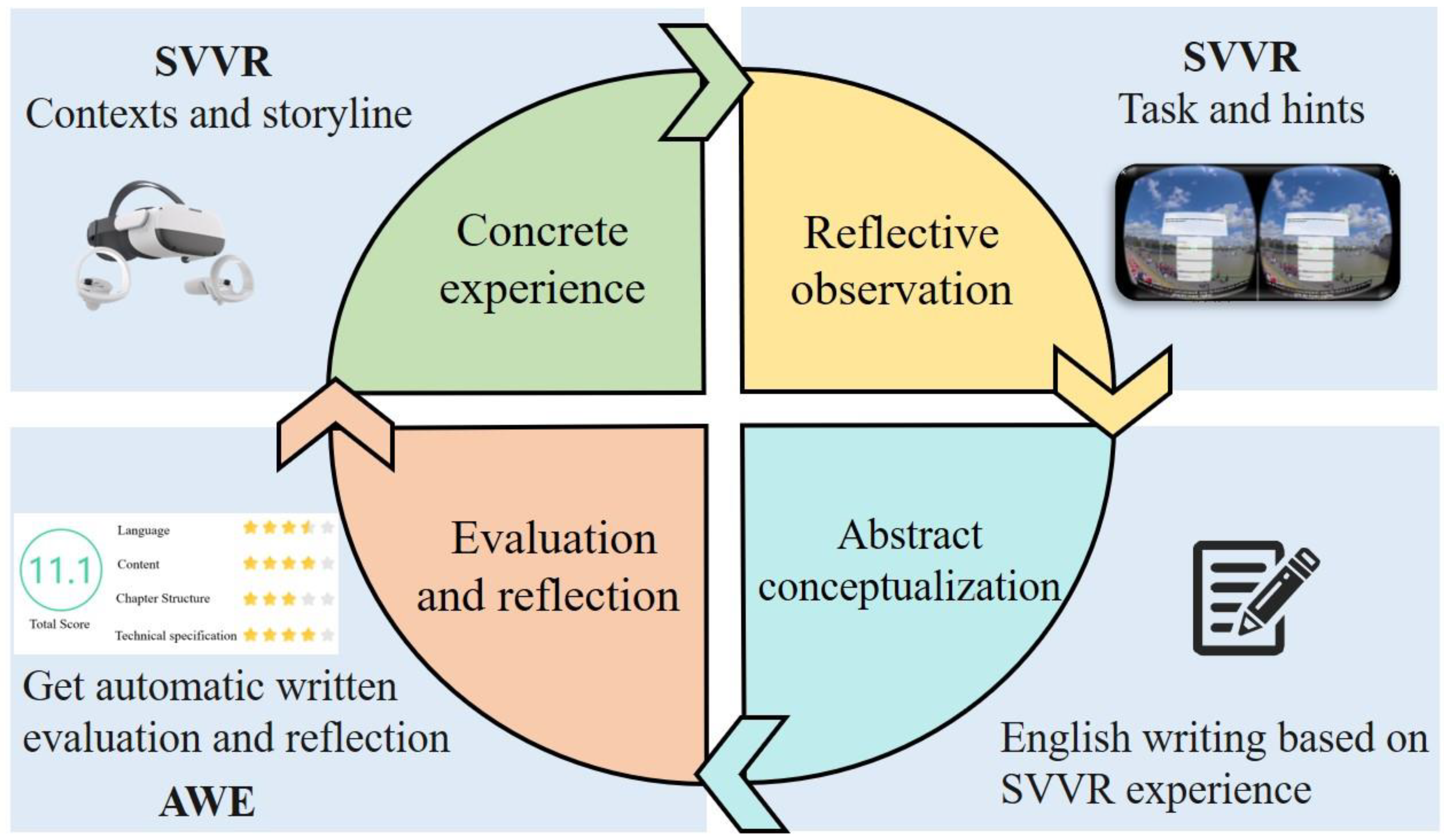
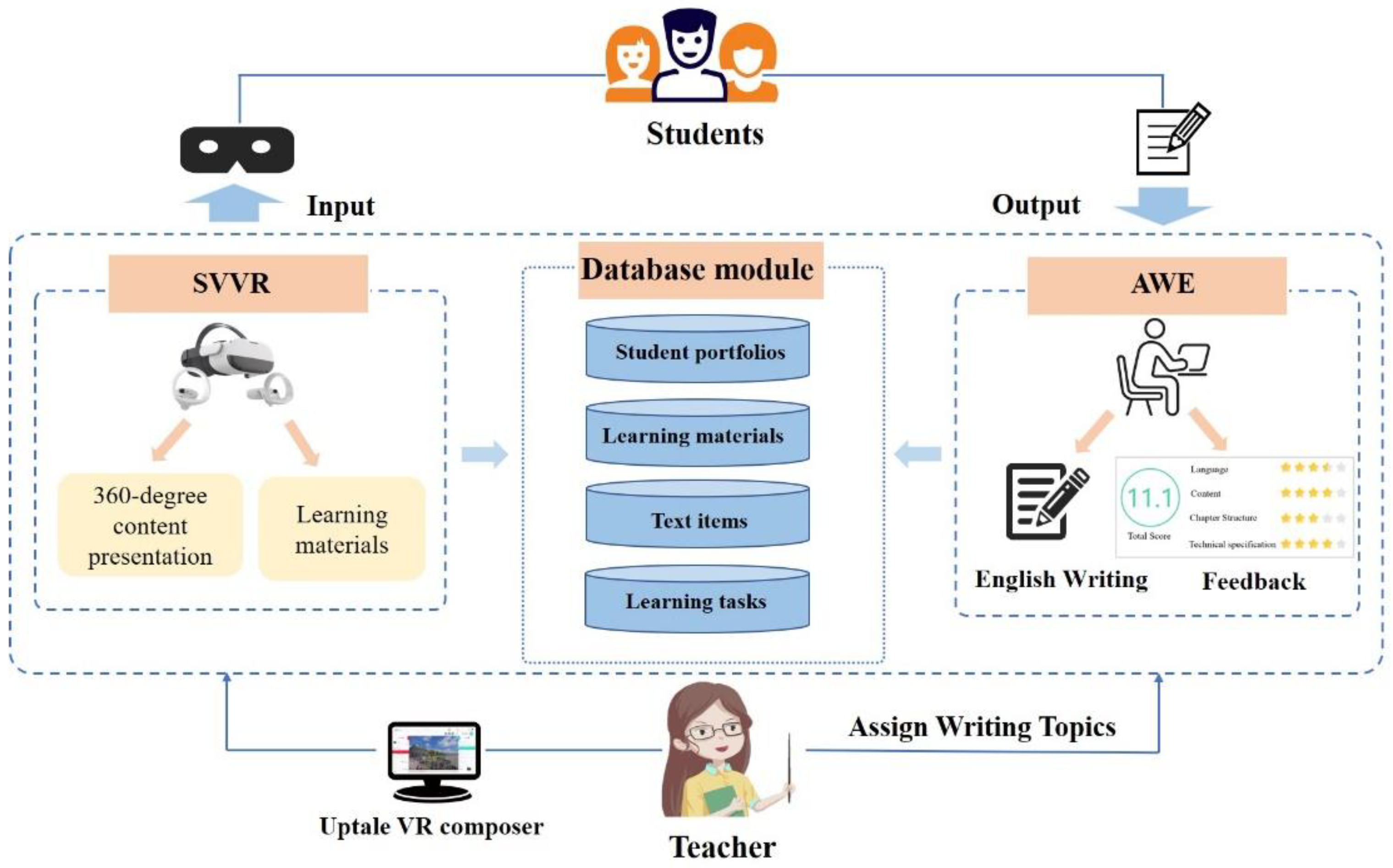
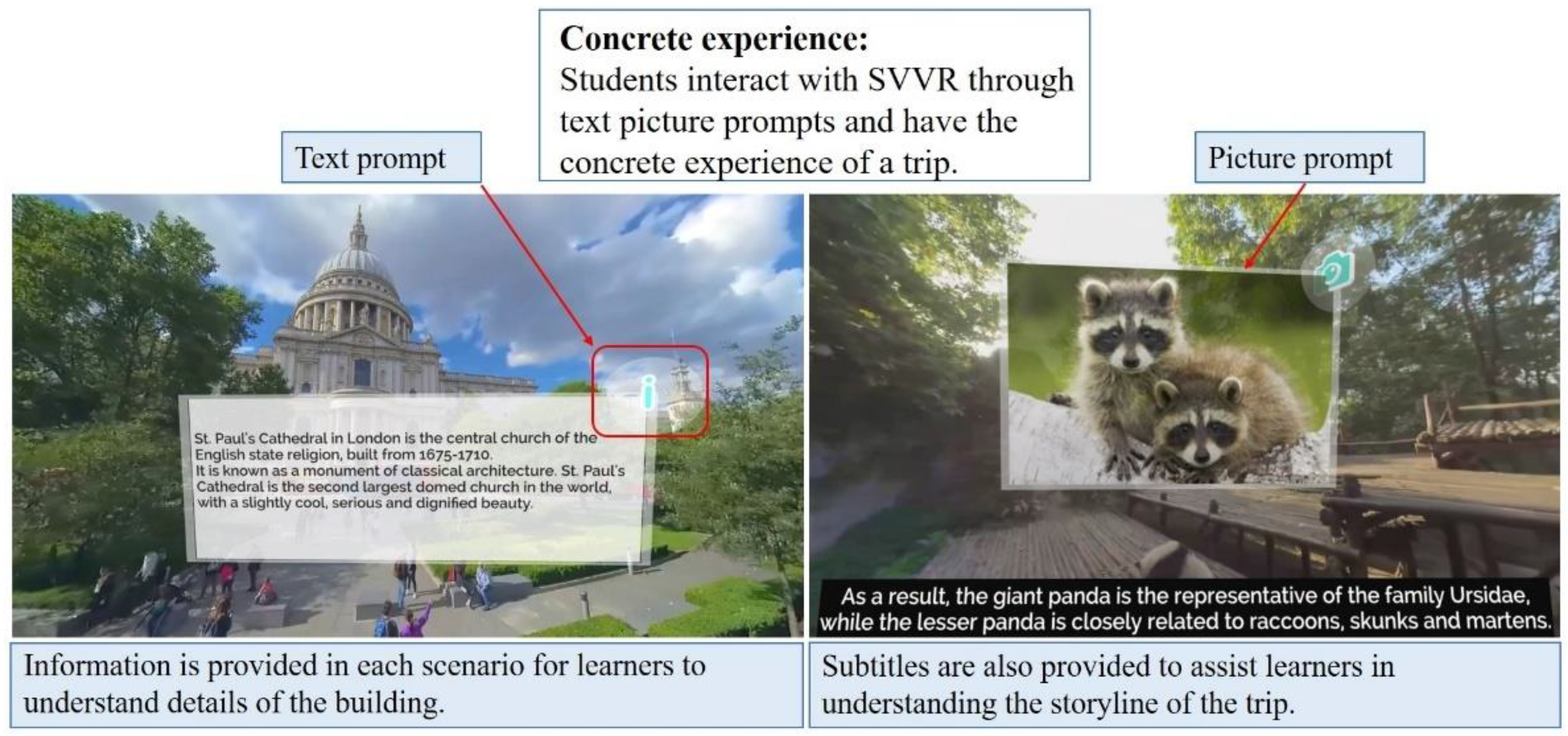
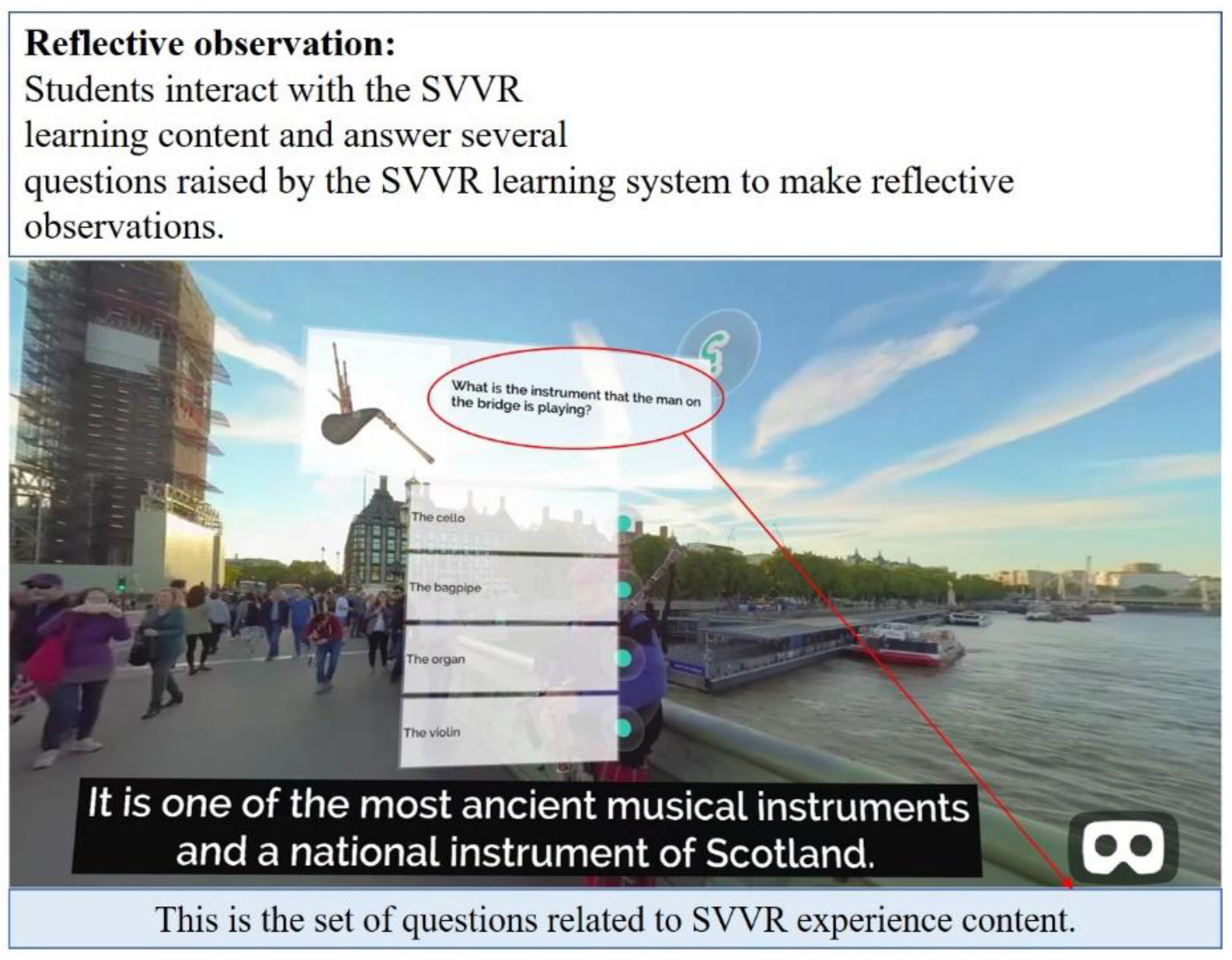
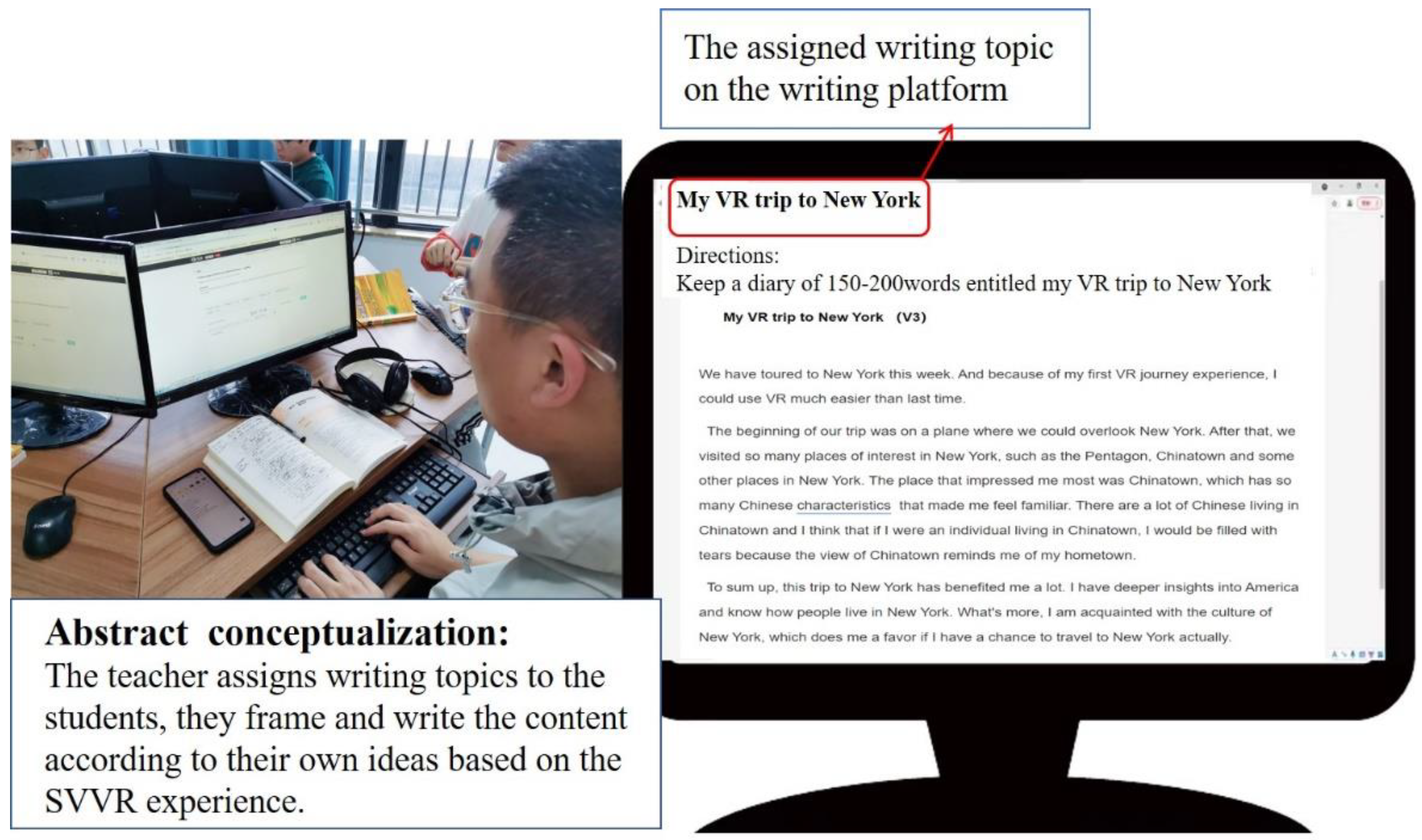
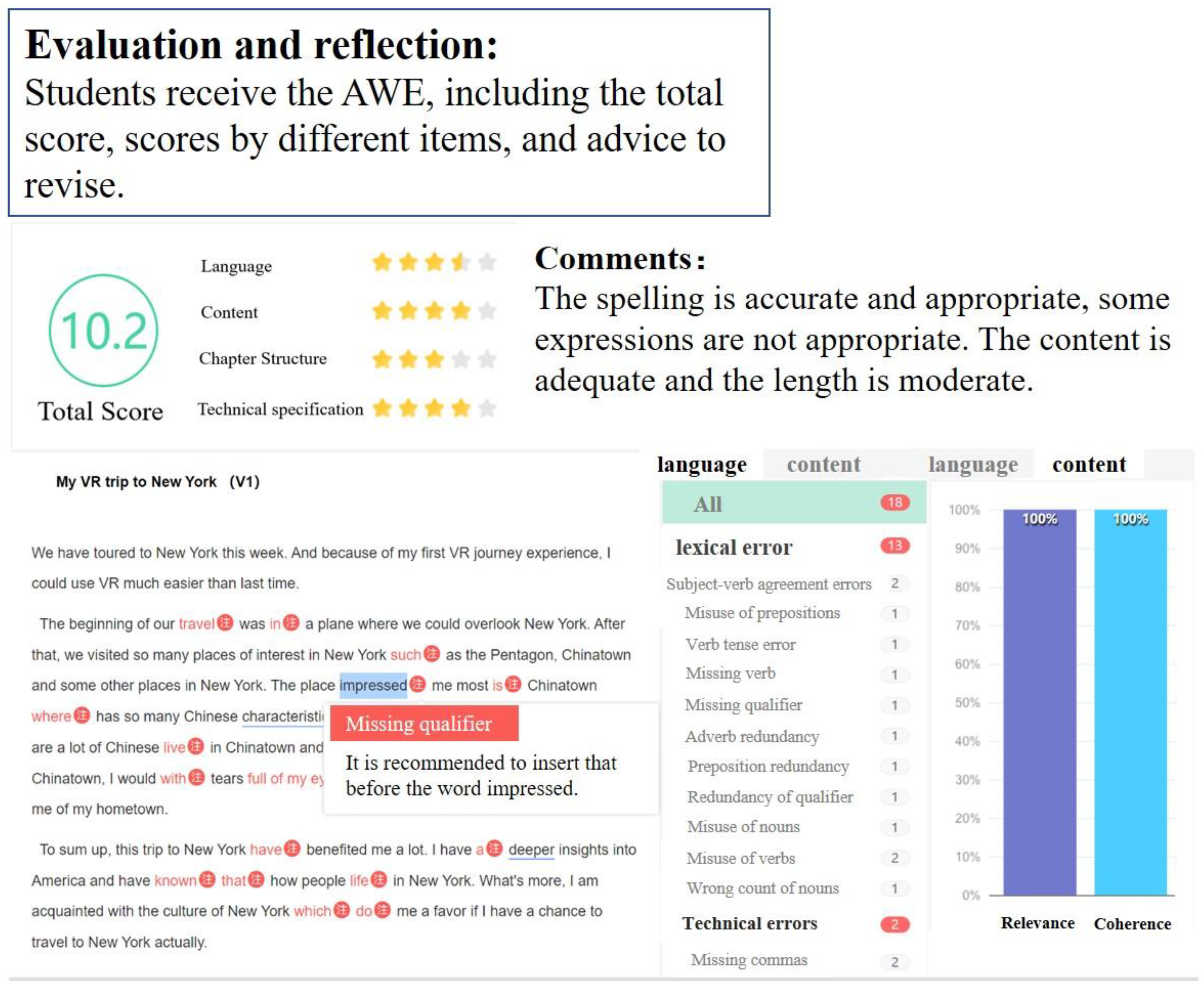

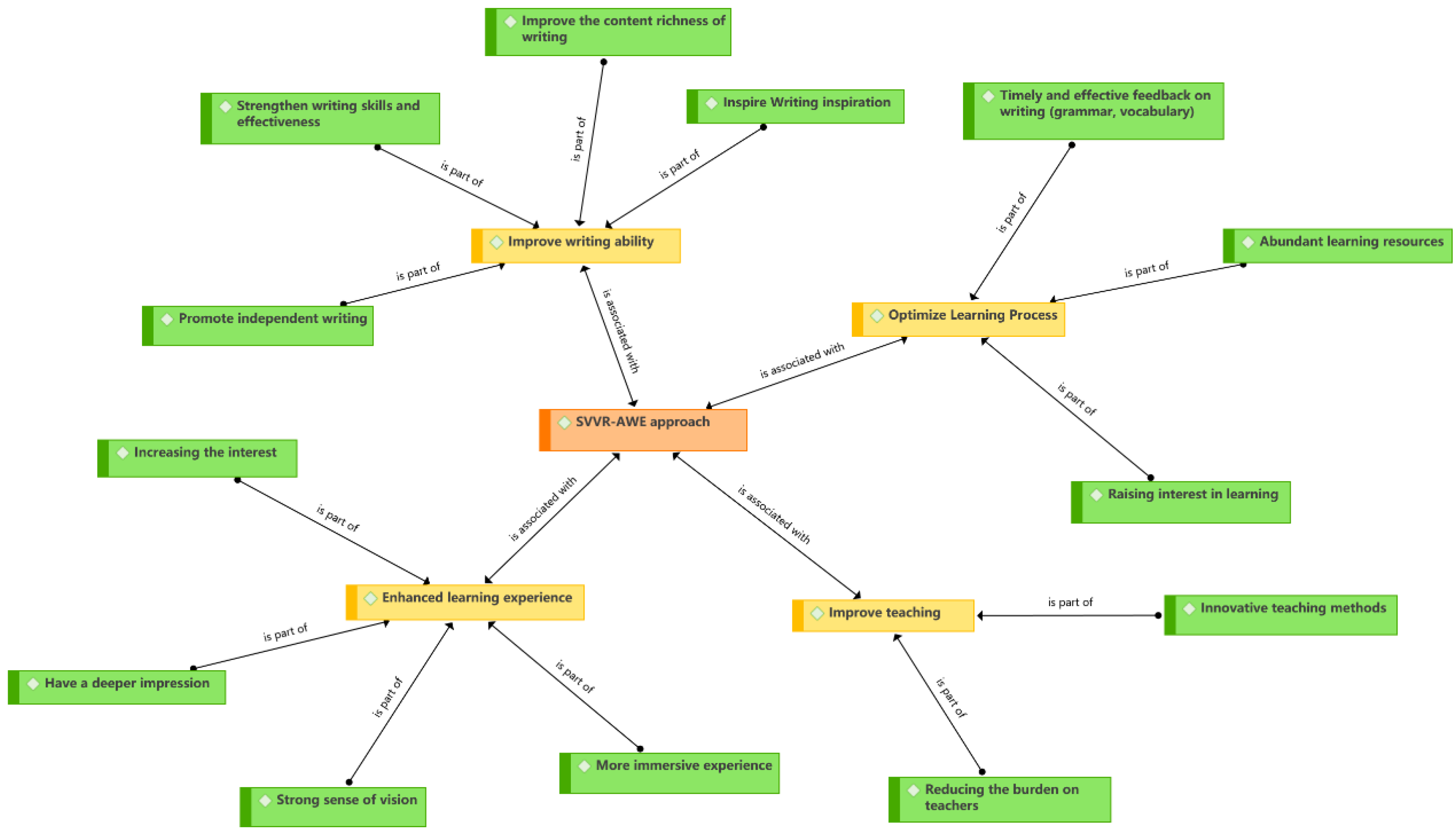
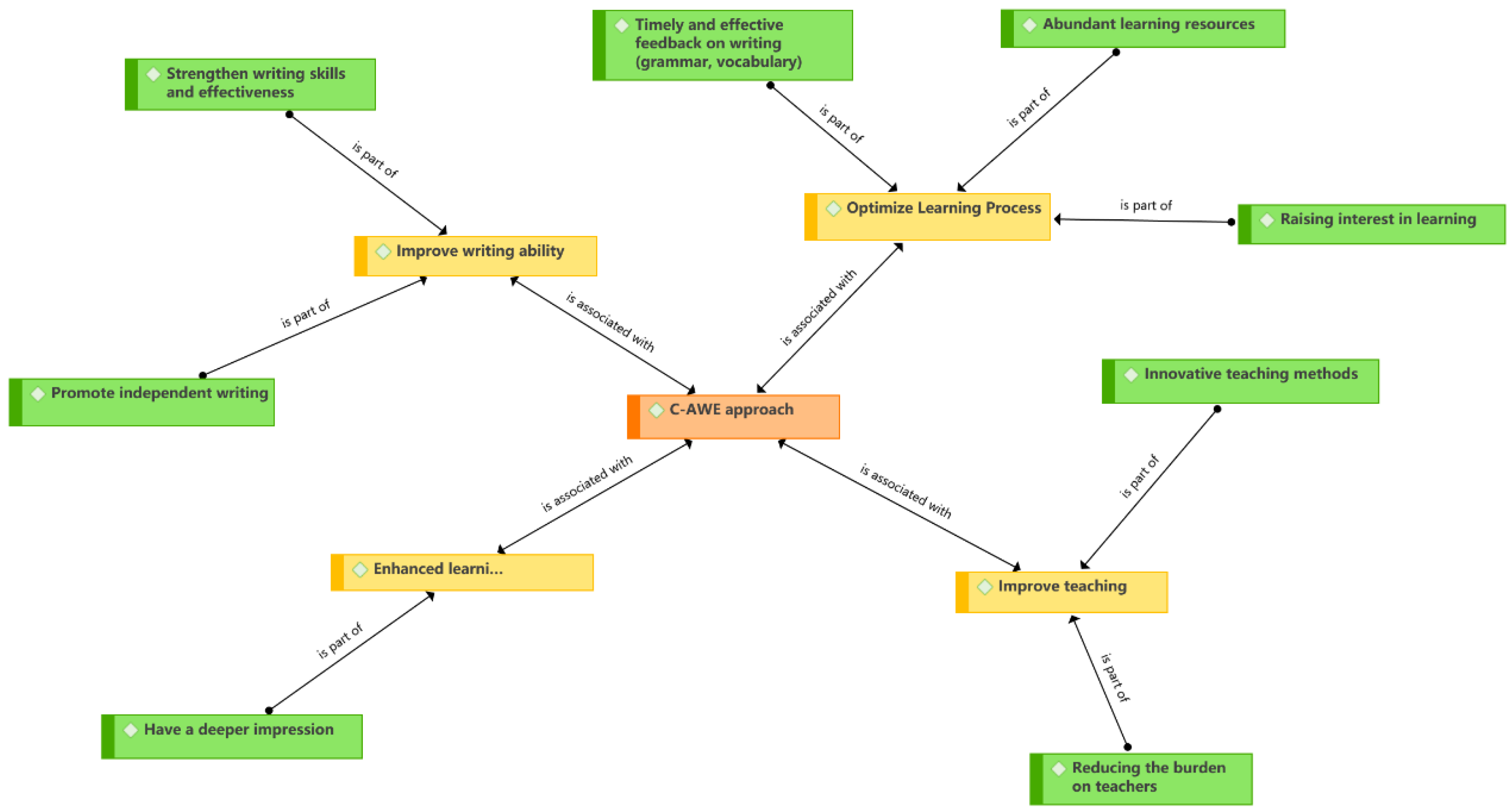
| Group | N | Mean | SD | Adjusted Mean | Std. Error | F | η2 |
|---|---|---|---|---|---|---|---|
| Experimental group | 37 | 33.65 | 2.31 | 33.63 | 0.36 | 8.61 ** | 0.11 |
| Control group | 39 | 32.15 | 2.49 | 32.17 | 0.35 |
| Writing Performance | Group | N | Mean | SD | Adjusted Mean | Std. Error | F | η2 |
|---|---|---|---|---|---|---|---|---|
| Organization of content | Experimental | 37 | 13.32 | 0.94 | 13.31 | 0.14 | 9.46 ** | 0.12 |
| Control | 39 | 12.69 | 0.95 | 12.70 | 0.14 | |||
| Linguistic accuracy | Experimental | 37 | 7.43 | 0.80 | 7.46 | 0.13 | 1.90 | 0.03 |
| Control | 39 | 7.23 | 0.87 | 7.21 | 0.12 | |||
| Originality | Experimental | 37 | 4.57 | 0.56 | 4.50 | 0.10 | 4.82 * | 0.06 |
| Control | 39 | 4.13 | 0.77 | 4.19 | 0.10 | |||
| Fluency | Experimental | 37 | 4.24 | 0.55 | 4.24 | 0.10 | 0.07 | 0.001 |
| Control | 39 | 4.21 | 0.66 | 4.21 | 0.10 | |||
| Elaboration | Experimental | 37 | 4.08 | 0.60 | 4.13 | 0.09 | 4.41* | 0.06 |
| Control | 39 | 3.90 | 0.60 | 3.86 | 0.09 |
| Group | N | Mean | SD | Adjusted Mean | Std. Error | F | η2 |
|---|---|---|---|---|---|---|---|
| Experimental group | 37 | 24.19 | 3.31 | 23.84 | 0.44 | 4.56 * | 0.06 |
| Control group | 39 | 22.18 | 2.90 | 22.52 | 0.43 |
| Group | N | Mean | SD | Adjusted Mean | Std. Error | F | η2 |
|---|---|---|---|---|---|---|---|
| Experimental group | 37 | 55.84 | 8.53 | 55.39 | 1.27 | 4.68 * | 0.06 |
| Control group | 39 | 51.13 | 9.61 | 51.55 | 1.24 |
| Group | N | Mean | SD | Adjusted Mean | Std. Error | F | η2 |
|---|---|---|---|---|---|---|---|
| Experimental group | 37 | 26.03 | 5.42 | 26.77 | 0.57 | 5.17 * | 0.07 |
| Control group | 39 | 29.28 | 4.77 | 28.58 | 0.55 |
| No. | Dimensions | Mean | SD |
|---|---|---|---|
| 1 | I had a sense of immersion in this learning activity. | 4.57 | 0.50 |
| 2 | The virtual scenes at the event seemed more like real places to me. | 4.57 | 0.50 |
| 3 | When I look back on the experience later, I feel that the scene is like a place I have visited, not just an image. | 4.51 | 0.51 |
| 4 | During the event, the virtual experience of the scenario made me feel strongly. | 4.51 | 0.51 |
| 5 | During the experience, I often forget that I am only wearing the virtual device for the activity. | 4.38 | 0.49 |
Publisher’s Note: MDPI stays neutral with regard to jurisdictional claims in published maps and institutional affiliations. |
© 2022 by the authors. Licensee MDPI, Basel, Switzerland. This article is an open access article distributed under the terms and conditions of the Creative Commons Attribution (CC BY) license (https://creativecommons.org/licenses/by/4.0/).
Share and Cite
Wang, Y.; Luo, X.; Liu, C.-C.; Tu, Y.-F.; Wang, N. An Integrated Automatic Writing Evaluation and SVVR Approach to Improve Students’ EFL Writing Performance. Sustainability 2022, 14, 11586. https://doi.org/10.3390/su141811586
Wang Y, Luo X, Liu C-C, Tu Y-F, Wang N. An Integrated Automatic Writing Evaluation and SVVR Approach to Improve Students’ EFL Writing Performance. Sustainability. 2022; 14(18):11586. https://doi.org/10.3390/su141811586
Chicago/Turabian StyleWang, Youmei, Xia Luo, Chen-Chen Liu, Yun-Fang Tu, and Naini Wang. 2022. "An Integrated Automatic Writing Evaluation and SVVR Approach to Improve Students’ EFL Writing Performance" Sustainability 14, no. 18: 11586. https://doi.org/10.3390/su141811586
APA StyleWang, Y., Luo, X., Liu, C.-C., Tu, Y.-F., & Wang, N. (2022). An Integrated Automatic Writing Evaluation and SVVR Approach to Improve Students’ EFL Writing Performance. Sustainability, 14(18), 11586. https://doi.org/10.3390/su141811586






